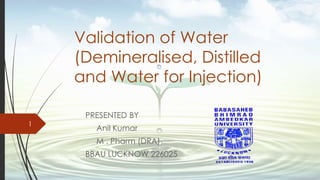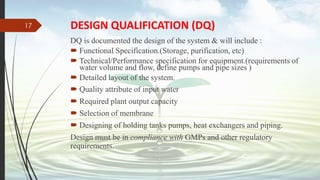Validation of water
- 1. Validation of Water (Demineralised, Distilled and Water for Injection) PRESENTED BY Anil Kumar M . Pharm (DRA) BBAU LUCKNOW 226025 1
- 2. CONTENTS Objectives Introduction Validation & System Qualification Monitoring Maintenance Revalidation & Change control Validation report Validation documentation Summary 2
- 3. Objective General information on water systems Design and engineering aspects of water systems Inspection of water systems The need for water quality manual reason for usage of pharmaceutical water supply systems. The technical requirements for water supply systems. Different types of water supply systems. Validation requirements. Qualification & inspection requirement 3
- 4. Introduction Water may be referred to as ‘the elixir of life’ – In the pharmaceutical industry for which the quality of water is critical and a high priority. Water is an essential ingredient of various pharmaceutical preparations and is also used to clean process equipment and hence, plays a pivotal role in pharmaceutical processing's. Water is the most widely used raw material in the manufacture of Active Pharmaceutical Ingredients (API),in intermediates, in finished dosage forms. Water is thus an important raw material in GMP and in validating the manufacturing process. 4
- 5. Continued……. Why purification? Although tap water is reasonably pure, it is always variable due to seasonal variations, regional variation in quality. One must remove impurities and control microbes to avoid contamination of products. Pretreatment depends on quality of feed water. 5
- 6. Continued……. Quality of water should be specific for product quality. Water contains, Organic and inorganic impurities Microbial contamination Endotoxin Particulate contamination Low quality of water can lead to product degradation product contamination loss of product and profit 6
- 7. TYPES OF WATER Different grades of Water for Pharmaceutical Purposes-each type has its on characteristic for all parameters. Potable water Purified water Water for injection(WFI) Sterile water for injection, inhalation, irrigation. Bacteriostatic water for injections. 7
- 8. Potable water Used in early stages of chemical synthesis. Used early stages of equipment cleaning. Sources: Public water supply, wells or combination of >1 of these Must meet requirement of USEPA(40 CFR 141) Seasonal variations of quality may occur and must be considered for treatment before usages. 8
- 9. Purified water ( Demineralised, Distilled ) Used as excipients in manufacturing of Pharmaceuticals. Used for equipment cleaning Preparation of bulk chemicals. Prepared using potable water as feed. Types of Purification: Deionisation, Distillation, Ion exchange, Reverse osmosis, filtration. Must meet ionic, organic chemical and microbial requirements. System that produce, store and circulate water under ambient conditions are susceptible to bio films. This can be provided by frequent sanitization and monitoring. 9
- 10. Water for injections Used as excipient in manufacturing of potentials. Used for equipment cleaning esp. product contact surfaces of sterile products. Preparation of sterile bulk chemicals. Prepared using purified water as feed. Method of preparation is multicolumn distillation. Must meet ionic, organic chemical, microbial and endotoxins requirements. Factors like microbial contamination and endotoxins should be controlled by circulation, frequent sanitization and monitoring. 10
- 11. DIFFERENT EQUIPMENTS AND COMPONENTS FOR WATER SYSTEM Piping Valves Pumps Pressure gauges Heat exchangers Distillation unit Filters Deionizers Sensors Auxiliary equipment 11
- 12. VALIDATION CONCEPT To prove the performance of processes or systems under all conditions expected to be encountered during future operations. To prove the performance, one must demonstrate (document) that the processes or systems consistently produce the specified quantity and quality of water when operated and maintained according to specific written operating and maintenance procedures. validation involves proving- 1. Engineering design 2. Operating procedures and acceptable ranges for control parameters 3. Maintenance procedures to accomplish it 12
- 13. Continued……. the system must be carefully, -designed -installed -tested during processing, after construction, and under all operating conditions. Variations in daily, weekly and annual system usage patterns must be validated. 13
- 14. WHY VALIDATION OF WATER SYSTEM? To ensure reliable, consistent production of water of required quality To operate system within design capacity To prevent unacceptable microbial, chemical and physical contamination during production, storage and distribution To monitor system performance, storage and distribution systems 14
- 15. Water System Qualification Validation Master Plan User Requirement Specification Design Qualification Operation Qualification 15
- 16. Operation Qualification Performance Qualification Re- Qualification Sign-off Report 16
- 17. DESIGN QUALIFICATION (DQ) DQ is documented the design of the system & will include : Functional Specification.(Storage, purification, etc) Technical/Performance specification for equipment.(requirements of water volume and flow, define pumps and pipe sizes ) Detailed layout of the system. Quality attribute of input water Required plant output capacity Selection of membrane Designing of holding tanks pumps, heat exchangers and piping. Design must be in compliance with GMPs and other regulatory requirements. 17
- 18. Operational Qualification The purpose of OQ is to establish, through documented testing, that all critical components are capable of operating within established limits and tolerances. Operation Qualification Checks- Identification of dead legs Slope verification Weld inspection Pressure test Passivation The purpose of OQ is also to verify and document that the water supply system provides acceptable operational control under “at-rest” conditions. 18
- 19. Installation Qualification IQ is in the form of checklist and it should include- Water velocity test Turbulence flow test (Reynolds number) Quality attribute of output water Prepare operational SOP Prepare cleaning and sanitation SOP Design action and alert limit Collection and collation of supplier operating and working instructions and maintenance requirements 19
- 20. Performance Qualification The purpose of PQ is to verify and document that water supply system provides acceptable control under ‘ Full Operational ‘ conditions. Qualification phases Phase I (investigational step): sampling and testing (4-6 weeks) Phase II (verification step): sampling and testing (2-4 weeks) Phase III (satisfactory completion step): sampling and testing (Yearly activity, seasonal monitoring) Establish action and alert limit PQ should follow successful completion of IQ and OQ. 20
- 21. MONITORING Monitoring and feed back data are important in maintaining the performance systems. Monitoring parameters include: Flow, pressure, temperature, conductivity, TOC Samples taken: From points of use, and specific sample points In a similar way how water is used in service Tests should include physical, chemical and microbial attributes For example, stable state can be achieved by applying automatic continuous monitoring of TOC and conductivity of the water system. They are the major quality attributes of water by which organic and inorganic impurities can be determined. 21
- 22. MAINTENANCE Specified limits for purified water and water for injection cfu* = colony forming units; ppb** = parts per billions; EU*** = endotoxin units Parameter Purified water Water for injection Conductivity < 1.3 μs/cm at 25 °C < 1.3 μs/cm at 25 °C pH 5.0-7.0 5.0-7.0 Bacteria < 100 cfu*/ml < 10 cfu/100ml Total organic carbon < 500 ppb** < 500 ppb Endotoxins N/A < 0.25 EU***/ml 22
- 23. CONTINUED… A controlled, documented maintenance covering : Defined frequency with plan and instructions Calibration programme SOPs for tasks Control of approved spares Record and review of problems and faults during maintenance 23
- 24. CONTINUED… System sanitization and bioburden control Systems in place to control proliferation of microbes Techniques for sanitizing or sterilization Consideration already during design stage – then validated Special precautions if water not kept in the range of 70 to 80 degrees Celsius 24
- 25. REVALIDATION & CHANGE CONTROL Once the validation is completed, the standard operating procedures (SOPs) are formalized. Routine operation should be performed according to the established SOP. If any deviation from SOP observed, determine the change and their impact on whole system Revalidation and evaluation should be performed depending upon the impact of the change on system. 25
- 26. VALIDATION REPORT Written at the conclusion of the equipment IQ, OQ and at completion of process validation. Will serve as primary documentation for FDA regulatory inspection Will serve as reference document when changes to the system are occurred and revalidation is needed. 26
- 27. VALIDATION DOCUMENTATION Verification of design documentation, including o Description of installation and functions o Specification of the requirements Instructions for performance control Operating procedures Maintenance instructions Maintenance records Training of personnel (program and records) Environmental records Inspection of plant Finally certification (Sign Off) by Engineering, User (Production) and QA Heads. 27
- 28. SUMMARY Validation of water (demineralized, distilled and water for injection): Play a major role in the quality of pharmaceuticals. Must be designed properly by professionals. Must be validated as a critical system. 28
- 29. SUGGESTED READING Munson, T.E. “FDA View on Water System Validation.” Proceedings of the Pharm. Tech. Conference 10-12 September 1985. “FDA : Water for Pharmaceutical Purposes.” Inspection Technical Guide 1986 No. 46. Rockville, Md., USA. Food and Drug Administration, Public Health Services, Department of Health and Human Services. Rakesh Pahwa1*, Mona Piplani1, “Validation Aspects of Water Treatment Systems for Pharmaceutical Products”, Tropical Journal of Pharmaceutical Research, February 2010; 9 (1): 81-90 Vineet sharma, ”Design, Qualification, and Validation of Water Systems”, Originally published in the November, 2004 issue of the Journal of Validation Technology. 29
- 30. Thanks……. for hearing my presentation….. any question friends……. 30





























